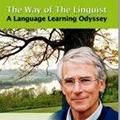In my view, there are three divergent approaches to language learning, divergent in terms of their emphasis or principal focus. This is true whether we learn in the classroom, online or on the street. One approach focuses on input, another on output, and a third on what I would call short cuts and some people call language hacking techniques. These techniques include grammar study, studying vocab lists and phrase books, heavy use of Flash Cards,"deconstructing the language", memory techniques and so forth. Any successful language learning program uses some of all three approaches. Where proponents of different approaches disagree is on the emphasis.
As many of you know, I favour an emphasis on input. The input should be interesting and meaningful for the learner, although this is harder to do for beginners. I believe that the preponderance of input based activities is just natural to the way we use language, even our own. In any conversation, especially if there are more than two people involved, we mostly listen. If we add to that our listening to radio, and television or classroom lectures, and then toss in reading, that wonderful human invention that enables us to communicate with the thoughts and ideas of people we do not know, in places, cultures and even eras, that are removed from our own little world, we are mostly consumers of input, not producers of output. This is the same when we learn a language.
I see three circles. One is large and represents input. This is where we acquire familiarity with a language, get to know its words and structure naturally. We prepare our brain for the language, so that the bits and pieces, grammar rules, or words and phrases can stick, eventually. We acquire this input from reading and listening to things that matter to us. These can be a novel, a newspaper article, a story, or a short content item from a beginner's book. Talking to native speakers is a great source of meaningful input. It has relevance and credibility. It is, however, usually harder to arrange as a beginner, unless it is with a teacher, since we are not able to say much. On the other hand input activities are easy and inexpensive to do. We can listen or read while on a train, or listen while doing the dishes or going for a run. We can use dead time for our learning.
The next circle is much smaller and sits inside the first circle. It is the output circle, speaking and writing. That is where we train ourselves to use the words and phrases of the language that we learn passively from input. This is also a great way to discover our gaps, and start to notice them better when we listen and read. Our volume of output grows as we acquire more words and phrases from our input activities. At the beginner stage, is difficult to engage native speakers in conversation unless they are good friends or teachers. It is often easier to start by writing, but that requires a lot of discipline. Our desire to produce output usually grows as we acquire more familiarity with the language, more words and phrases, and want to try these things out with other people. We usually know when we want to produce output.
The third circle sits inside the second circle and is a little smaller than the output circle. We spend less time here, but check in every now and then. Books with lists of words and phrases, or grammar rules, are, to me, hard to understand and remember until we have had enough input. I have tried learning from phrase books as a beginner and I could not remember them, because I had no context. The same is true of grammar rules. However, once I have had a lot of exposure to the language through interesting and meaningful input activities, these phrase books and grammar rules are easier to use. They can help me fill in gaps in my knowledge.
Language learning is still largely a matter of finding a way to enjoy the process. The golden trinity of Attitude, Time on task, and Attentiveness are the keys. Obviously if we enjoy learning, we will have a good attitude, put in the time and remain alert to the language. Different people enjoy different ways of learning.
What I have outlined here is how I like to learn, and this approach is at the core of LingQ. I wanted to set this out, before I move on to a discussion of Benny's recent review of LingQ and then move on to review Benny's site, "fluency in three months."

